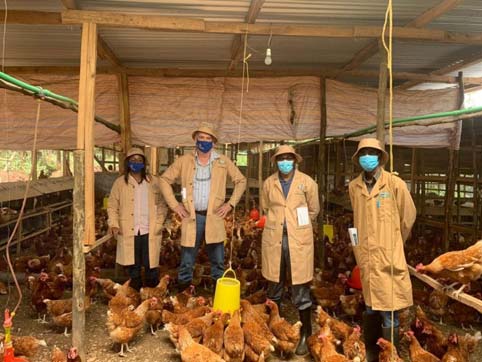Funded by the U.S. Department of Agriculture’s Quality Sampling Program (QSP), the U.S. Grains Council (USGC) procured and shipped 60 metric tons (MT) (2,362 bushels) of U.S. sorghum to Mombasa, Kenya, in late 2020. Over the subsequent 12 months, the Council implemented a series of poultry feeding trials to demonstrate how U.S. sorghum performs as an alternative energy source that can reduce overall formulation cost – the first step toward
opening the market to regular sales.
While sorghum use in animal feeds is common in many markets in which the Council operates, it has been seldom used in Kenya due to the industry’s lack of familiarity with the product. The Council’s sorghum trials set out to demonstrate to the commercial feed industry in Kenya the quality, benefits, and performance of U.S. sorghum when included in poultry diets.
The poultry trials were conducted in partnership with Unga Farm Care, one of the largest commercial feed manufacturers in East Africa, in Nairobi, Kenya. Two separate trials, one broiler (meat) and one layer (egg), were conducted, showcasing U.S. sorghum’s performance as a replacement for local white corn.
As part of the trial, 3,200 layers and 5,000 broilers were placed on a poultry farm 60 miles outside of Nairobi in February 2021. The birds were monitored daily for 51 weeks to track performance. The corn and the sorghum diet trial birds had similar growth, live weights, health and egg production, effectively
demonstrating that sorghum can serve as an alternative energy source in both broiler and layer feed rations without compromising performance, which had been a concern of the industry.
Kenya’s feed industry is largely dependent on local white corn, which is the most commonly used energy source in poultry feed rations. Due to inconsistency in supply and quality, the Kenyan feed industry often must turn to its neighboring countries, namely Tanzania and Uganda, for corn imports. Feed costs in Kenya have been on the rise in recent years, largely due to the high cost of feed ingredients led by white corn, which can account for up to 80 percent of the cost of production. The Council’s feeding trials have resulted in the Kenyan industry making inquiries about how to procure U.S. sorghum.
The Council estimates that Kenya could easily import 500 – 800 thousand metric tons (TMT) (19,684,000-31,494,400 bushels) of U.S. sorghum annually with an export value of $200-300 million when the local corn crop is out of the market.
About The U.S. Grains Council
The U.S. Grains Council develops export markets for U.S. barley, corn, sorghum and related products including distiller’s dried grains with solubles (DDGS) and ethanol. With full-time presence in 28 locations, the Council operates programs in more than 50 countries and the European Union. The Council believes exports are vital to global economic development and to U.S. agriculture’s profitability. Detailed information about the Council and its programs is online at www.grains.org.

